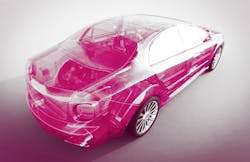NASHVILLE, TENN., Dec. 7, 2021—As covered earlier during the ADAPT: Automotive Technology Summit, working on ADAS and other emerging vehicle technologies is going to become a necessity for independent shops to thrive in the coming years.
So much emphasis is placed on shop owners and their staff members to have the necessary information and skillset to work on new vehicle tech, specifically ADAS calibrations, and rightfully so. Having the proper space and shop layout is equally as important.
During the final day of the summit, a panel of four shop owners and managers in both the collision and mechanical sectors went through what shops looking to get into the calibration scene need to do to ensure their facility can handle it.
Making the Leap
Darell Amberson and Jason Ziese of LaMettry’s Collision in Minnesota said their shop has been working with ADAS calibrations and other tech for almost 10 years at this point. Because of that, they’ve had a natural evolution of sorts and have acquired new tools as they’ve progressed throughout the years.
“We started with a combination of aftermarket and OEM tools, and there are some aftermarket tools that perform really well, but along the way we made the decision to do more factory tools,” said Amberson, who is president of operations for LaMettry’s. “With our OE certifications, we tend to lean more toward the factory tools.”
Bryan Kauffeld, owner of Ulmer’s Auto Care, made the decision more recently to jump into the calibration and diagnostics markets, converting a space near his Cincinnati, Ohio, shop into a calibration center just under two years ago.
Even though Kauffeld’s shop didn’t naturally progress with new technologies and still took a major investment to get off the ground, his repair shop already had several of the tools it needed.
“Coming from the mechanical side, we already had a bunch of the OEM tools. Once we opened our ADAS center, we purchased tools as we needed them,” Kauffeld said. “Over the course of the first three months, we acquired just about all of the OE tools.”
Maximize Your Space
Michelle Corson, CEO of On the Road Garage, says it’s easy to underestimate just how much space is needed for a calibration center.
“We set out with our company wanting to be very tech-forward, and we designed our facility with ADAS in mind. One of the very first things we discovered was that, even though we allotted a lot of space, we didn’t have enough,” Corson said. “A lot of vehicles need a lot of room all around the vehicle. Body shops that are doing calibrations need to make sure they can accommodate that when they start doing calibrations.”
According to the panel discussion, the average body stall in a shop is about 300-400 square feet. When performing calibrations, you need the space for the vehicle and then another 1500-2000 square feet around the vehicle to accurately test the sensors and cameras.
Zeise, who is LaMettry’s mechanical operations manager, said they have an open work space that’s roughly 37’ x 40’.
Space, while important, isn’t the only consideration shops need to make.
“In our dedicated calibration room now, we have no outside light. There are adjustable LED lights that hang from the ceiling,” Zeise said. “We have a white sheetrock floor with an epoxy coating. You want to have total control over the conditions in that space.”
Having an organized space with ample storage for tools and hardware is essential to maximize workflow efficiency as well.
Tools and Training
On top of the space required, a shop doing calibrations needs proper equipment and a staff that knows how to use it.
The four panelists said their shops all use some combination of OEM and aftermarket tools, though there was a consensus that new vehicles usually require use of original equipment.
“You have to do your homework and know the limitations of your tools. If you’re working on a brand-new vehicle, you’re going to have to use an OE tool,” Ziese said. “You can learn a lot from experimenting.”
More important than the equipment though, Amberson said, is making sure your team knows how to use it.”
“We’re happy to try almost any tool or piece of equipment, whether it’s OEM or aftermarket, and learn from it,” Amberson said. “The more important conversation is the competence of the person using the tool.”
There are plenty of training resources such as I-CAR, but Ziese and Amberson said the best way to learn is to do some good, old-fashioned research using OEM repair procedures and experimenting with different methods.
Return on Investment
Becoming tech-focused is an investment, and oftentimes it’s a large one.
Kauffman said it cost around $225,000 to get the necessary equipment and software, and Corson said for her shop it was around $375,000.
The panel advised that people need to be certain and to do their homework before making the jump, but it can prove to be a lucrative investment.
“We need to emphasize the tremendous opportunity this business provides,” Amberson said. “It’s not easy, there’s a lot of training that needs to be done, but in terms of potential growth, work environments and working on newer vehicles, there are a lot of opportunities.”
About the Author

Noah Brown
Noah Brown is a freelance writer and former senior digital editor for 10 Missions Media, where he facilitated multimedia production several of the company's publications.
